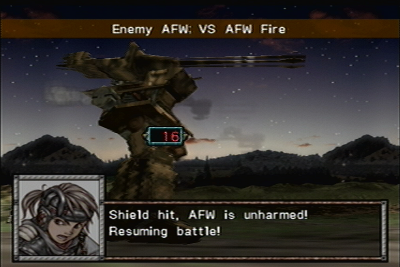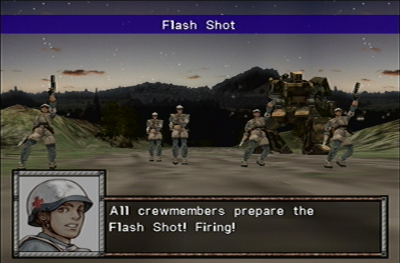Red Rings of Death
It’s not often I come across a PS2 game I haven’t heard anything about. I’m still not certain I hadn’t heard of Ring of Red before, but having played it some I’m that much more surprised.
It’s not that it’s an amazingly good game – far from it, it’s somewhat clunky and has an odd dichotomy of style (showing WWII-style videos alongside anime-drawn characters).

AFW firing is inaccurate at best, making the game feel more realistic (if more boring)
And yet, it’s this bizarre combination of WW2-esque aesthetic as well as anime style that makes this game feel right. Unlike more standard games and anime, the “mechs” (here called AFWs) are portrayed as surprisingly realistic – they have a crew to load and maintain them, are somewhat slow and clunky, and are supported on the ground by infantry.
It’s not like Ring of Red is particularly realistic – I haven’t ever thought of realism a great metric for a game’s quality, in any case – but its alternate history setting, in which Japan refused to surrender at the end of WW2 and became a territory divided between Stalin’s Russia and the United States, is surprisingly well-crafted (even if the excuse for walking tanks is a little bit far-fetched).

Infantry support uses skills to affect the course of battle
Gameplay is a little bit strange. Like Battle Stations or The Unholy War (if I’m remembering right), it is a standard tactical RPG until two units clash. At this point you go into a semi-action-mode wherein you have 90 seconds to fight the enemy. You can determine which of your three infantry units pilots the mech, and the other two act as ground support with various capabilities.
If well done, it would’ve been really great. The battle chatter amongst your units enhances the feeling of a WW2-esque conflict, and although the graphics are a bit dated the animations are decent. Unfortunately, as an early PS2 game, Ring of Red is far too obsessed with spectacle and does not allow you to skip animations or automate battles. This would be okay if the animations weren’t shown 3-4 times a battle, or if they were particularly impressive (they are nice the first few times, I suppose). When each engagement takes 90 seconds, you’re looking at taking up to 7 or 8 minutes to move each of your units. Although this isn’t horrible, and thus far missions have taken only slightly longer than a standard SRPG, I can imagine it will bog down as the game progresses.
Is it a great game? I highly doubt it. But it’s original, and that makes it worth trying in my book.